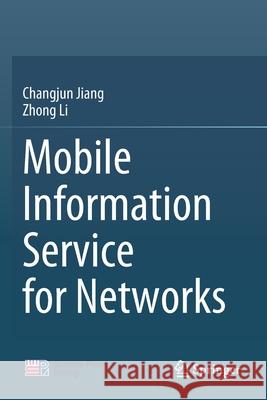Mobile Information Service for Networks » książka



Mobile Information Service for Networks
ISBN-13: 9789811545719 / Angielski / Miękka / 2021 / 242 str.
Mobile Information Service for Networks
ISBN-13: 9789811545719 / Angielski / Miękka / 2021 / 242 str.
(netto: 383,36 VAT: 5%)
Najniższa cena z 30 dni: 385,52
ok. 22 dni roboczych
Dostawa w 2026 r.
Darmowa dostawa!
Chapter One: Preliminary of Mobile Information Service for Networks
1.1 Concept and Development of Mobile Information Service for Networks
1.2 Network Communication Architecture
1.3 Classification of Mobile Information Service for Networks
1.4 Key Technologies of Mobile Information Service for Networks
1.5 Summary
References
Chapter Two: Technology of Neighbor Discovery for Networks
2.1 Introduction
2.2 Development of Neighbor Discovery Technology
2.3 Role-based Neighbor Discovery Algorithm
2.4 Neighbor Discovery Based on Crowded Scenes
2.5 Application Discussion
2.6 Summary
References
Chapter Three: High Efficient Routing and Balanced Association Technology of Mobile Networks
3.1 Introduction
3.2 Related Work
3.3 Routing Protocol Based on Social Relationship in Mobile Networks
3.4 Cognitive Routing Protocol for Internet of Vehicles
3.5 Mobile User Association Method for Load Balancing Based on Reinforcement Learning
3.6 Privacy Preservations Design
3.7 Application Discussion
3.8 Summary
References
Chapter Four:Network Community Structure Detection
4.1 Introduction
4.2 Related Work4.3 Adaptive Weighted Dynamic Community Detection Algorithm
4.4 Space-Crossing Community Detection
4.5 Application Discussion
4.6 Summary
Reference
Chapter Five: Platform of Mobile Information Service for Networks
5.1 System Design
5.2 Design of Data Format
5.3 Subsystem of Resource Scheduling Optimization
5.4 Online Monitoring Subsystem of Network Transaction
5.5 Subsystem of Traffic Online Analysis and Service
5.6 Summary
References
Chapter Six: Intelligent Transportation
6.1 Related Applications and Technologies
6.2 Road Status Predicting and Optimal Route Selection
6.3 Vehicle Behavior Analysis Based on Sparse GPS Data
6.4 Identification and Warning of Hazard Behavior Based on Neighboring Vehicles
6.5 Summary
References
Chapter Seven: Smart Tourism
7.1 Related Applications and Technologies
7.2 Location Recommendation Based on Collaborative Tensor Factorization
7.3 Partition-based Collaborative Tensor Factorization for POI Recommendation
7.4 Maximal-Marginal-Relevance-Based POIs List Recommendation
7.5 Summary
Reference
Chapter Eight: Mobile Payment Authentication
8.1 Related Applications and Technologies
8.2 Touch Screen Behavior Authentication System Based on User Postures
8.3 Construction and Certification of Login Authentication Model
8.4 Construction and Certification of Continuous Authentication Model
8.5 Summary
Reference
Changjun Jiang is a Professor and the current Vice President of Tongji University. He is also Chief Scientist of the National Program on the Key Basic Research Project of China (973 Program), Director of the Key Laboratory of Embedded System and Service Computing, Ministry of Education, and Director of Shanghai Electronic Transactions and the Information Service Collaborative Innovation Center. He won the second prize for National Science and Technology Progress in 2013 and 2016, and the second prize for National Technology Invention in 2010. His current research interests are in network concurrent theory, network risk prevention and control, network computing environments, and network information services.
Zhong Li is an Associate Professor at Donghua University. She received her Ph.D. degree from Tongji University, Shanghai, China, in 2015, and has since presided over the National Natural Science Foundation of China (General Program), Shanghai Rising-Star Program. She has published more than 20 papers in journals such as IEEE Transactions on Parallel and Distributed Systems, IEEE Transactions on Wireless Communications, IEEE Transactions on Intelligent Transportation Systems. Her main research interests are in the internet of vehicles, mobile computing, and network security.
This book introduces readers to mobile information services for networks. The content is divided into eight chapters, each of which presents a specific concept and the latest related developments in mobile information services. Mobile information services for networks can be defined as platform-independent functional entities that provide various services based on the communication network platform. The book discusses the three main supporting technologies for mobile information services: neighbor discovery in the data link layer; routing and balanced association in the network layer; and community structure detection in the application layer. Lastly, the book describes the development of applications based on the authors’ mobile information service platform, as well as related key technologies in the domains of intelligent transportation, smart tourism, and mobile payment, such as trajectory analysis, location recommendation, and mobile behavior authentication, which are promoting the development of mobile information services.
This book offers a valuable reference guide for researchers in the field of computer science and technology, as well as those in the field of network mobile information service technology.
1997-2025 DolnySlask.com Agencja Internetowa
KrainaKsiazek.PL - Księgarnia Internetowa









